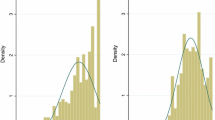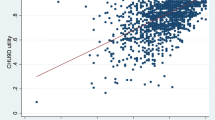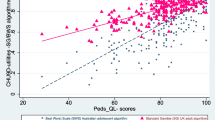Abstract
Purpose
The Pediatric Quality of Life Inventory™ (PedsQL™) General Core Scales (GCS) were designed to provide a modular approach to measuring health-related quality of life in healthy children, as well as those with acute and chronic health conditions, across the broadest, empirically feasible, age groups (2–18 years). Currently, it is not possible to estimate health utilities based on the PedsQL™ GCS, either directly or indirectly. This paper assesses different mapping methods for estimating EQ-5D health utilities from PedsQL™ GCS responses.
Methods
This study is based on data from a cross-sectional survey conducted in four secondary schools in England amongst children aged 11–15 years. We estimate models using both direct and response mapping approaches to predict EQ-5D health utilities and responses. The mean squared error (MSE) and mean absolute error (MAE) were used to assess the predictive accuracy of the models. The models were internally validated on an estimation dataset that included complete PedsQL™ GCS and EQ-5D scores for 559 respondents. Validation was also performed making use of separate data for 337 respondents.
Results
Ordinary least squares (OLS) models that used the PedsQL™ GCS subscale scores, their squared terms and interactions (with and without age and gender) to predict EQ-5D health utilities had the best prediction accuracy. In the external validation sample, the OLS model with age and gender had a MSE (MAE) of 0.036 (0.115) compared with a MSE (MAE) of 0.036 (0.114) for the OLS model without age and gender. However, both models generated higher prediction errors for children in poorer health states (EQ-5D utility score <0.6). The response mapping models encountered some estimation problems because of insufficient data for some of the response levels.
Conclusion
Our mapping algorithms provide an empirical basis for estimating health utilities in childhood when EQ-5D data are not available; they can be used to inform future economic evaluations of paediatric interventions. They are likely to be robust for populations comparable to our own (children aged 11–15 years in attendance at secondary school). The performance of these algorithms in childhood populations, which differ according to age or clinical characteristics to our own, remains to be evaluated.


Similar content being viewed by others
References
Dakin H, Petrou S, Haggard M, Benge S, Williamson I. Mapping analyses to estimate health utilities based on responses to the OM8-30 otitis media questionnaire. Qual Life Res. 2010;19(1):65–80. doi:10.1007/s11136-009-9558-z.
Culyer AJ. The dictionary of health economics. Cheltenham: Edward Elgar Publishing; 2005.
National Institute for Health and Care Excellence, (NICE). Guide to the methods of technology appraisal. National Institute for Health and Clinical Excellence (NICE); 2013.
Petrou S. Methodological issues raised by preference-based approaches to measuring the health status of children. Health Econ. 2003;12(8):697–702.
Tilford JM, Payakachat N, Kovacs E, Pyne JM, Brouwer W, Nick TG, et al. Preference-based health-related quality-of-life outcomes in children with autism spectrum disorders. Pharmacoeconomics. 2012;30(8):661–79.
Ungar WJ, Boydell K, Dell S, Feldman BM, Marshall D, Willan A, et al. A parent-child dyad approach to the assessment of health status and health-related quality of life in children with asthma. Pharmacoeconomics. 2012;30(8):697–712.
Griebsch I, Coast J, Brown J. Quality-adjusted life-years lack quality in pediatric care: a critical review of published cost-utility studies in child health. Pediatrics. 2005;115(5):e600–14.
Eiser C, Morse R. Quality-of-life measures in chronic diseases of childhood. Health Technol Assess (Winchester, England). 2001;5(4):1.
Longworth L, Bojke L, Tosh J, Sculpher M. MRC-NICE scoping project: identifying the National Institute for Health and Clinical Excellence’s methodological research priorities and an initial set of priorities. Centre for Health Economics, University of York Working Papers; 2009.
Stevens K. Valuation of the child health utility index 9D (CHU9D). 2010.
Longworth L, Rowen D. NICE DSU Technical Support Document 10: the use of mapping methods to estimate health state utility values; 2011.
Boyle SE, Jones GL, Walters SJ. Physical activity, quality of life, weight status and diet in adolescents. Qual Life Res. 2010;19(7):943–54.
The EQG. EuroQol-a new facility for the measurement of health-related quality of life. Health Policy. 1990;16(3):199–208.
Räsänen P, Roine E, Sintonen H, Semberg-Konttinen V, Ryynänen OP, Roine R. Use of quality-adjusted life years for the estimation of effectiveness of health care: a systematic literature review. Int J Technol Assess Health Care. 2006;22(02):235–41.
Dolan P. Modeling valuations for EuroQol health states. Med Care. 1997;35(11):1095–108.
Szende A, Oppe M, Devlin N. EQ-5D value sets: inventory, comparative review and user guide, vol. 2. Berlin: Springer; 2006.
Eidt-Koch D, Mittendorf T, Greiner W. Cross-sectional validity of the EQ-5D-Y as a generic health outcome instrument in children and adolescents with cystic fibrosis in Germany. BMC Pediatr. 2009;9(1):55.
Wille N, Ravens-Sieberer U. Age-appropriateness of the EQ-5D adult and child-friendly version: testing the feasibility, reliability and validity in children and adolescents. In: 23rd Scientific Plenary Meeting of the EuroQol Group in Barcelona, Spain, September 14, vol 16. 2006. p. 217–9.
Varni JW, Burwinkle TM, Seid M. The PedsQL TM 4.0 as a school population health measure: feasibility, reliability, and validity. Qual Life Res. 2006;15(2):203–15.
McCullagh P, Nelder JA. Generalized linear models, vol. 37. London: Chapman & Hall/CRC; 1989.
Manning WG, Mullahy J. Estimating log models: to transform or not to transform? J Health Econ. 2001;20(4):461–94.
Pearson E, Please N. Relation between the shape of population distribution and the robustness of four simple test statistics. Biometrika. 1975;62(2):223–41.
Pregibon D. Goodness of link tests for generalized linear models. Appl Stat. 1980;29:15–23.
Hosmer D. In: Lemeshow S (ed). Applied logistic regression. New York: Wiley; 1989. p. 8–20.
Glick HA, Doshi JA, Sonnad SS, Polsky D. Economic evaluation in clinical trials. USA: Oxford University Press; 2007.
Powell JL. Least absolute deviations estimation for the censored regression model. J Econometr. 1984;25(3):303–25.
Chay KY, Powell JL. Semiparametric censored regression models. J Econ Perspect. 2001;15(4):29–42.
Tobin J. Estimation of relationships for limited dependent variables. Econometrica: J Econ Soc. 1958;26(1):24–36.
Brazier J, Yang Y, Tsuchiya A, Rowen D. A review of studies mapping (or cross walking) non-preference based measures of health to generic preference-based measures. Eur J Health Econ. 2010;11(2):215–25. doi:10.1007/s10198-009-0168-z.
Pullenayegum EM, Tarride J-E, Xie F, Goeree R, Gerstein HC, O’Reilly D. Analysis of health utility data when some subjects attain the upper bound of 1: are Tobit and CLAD models appropriate? Val Health. 2010;13(4):487–94.
Pullenayegum EM, Tarride J-E, Xie F, O’Reilly D. Calculating utility decrements associated with an adverse event marginal Tobit and CLAD coefficients should be used with caution. Med Decis Making. 2011;31(6):790–9.
Papke LE, Wooldridge JM. Econometric methods for fractional response variables with an application to 401 (K) plan participation rates. J Appl Econ. 1996;11(6):619–32. doi:10.2307/2285155.
Levy A, Christensen T, Johnson J. Utility values for symptomatic non-severe hypoglycaemia elicited from persons with and without diabetes in Canada and the United Kingdom. Health Qual Life Outcomes. 2008;6(1):73.
Dakin H, Gray A, Murray D. Mapping analyses to estimate EQ-5D utilities and responses based on Oxford Knee Score. Qual Life Res. 2012;1–12.
Gray AM, Rivero-Arias O, Clarke PM. Estimating the association between SF-12 responses and EQ-5D utility values by response mapping. Med Decis Making. 2006;26(1):18–29. doi:10.1177/0272989x05284108.
Le QAPP, Doctor JNP. Probabilistic mapping of descriptive health status responses onto health state utilities using Bayesian networks: an empirical analysis converting SF-12 into EQ-5D utility index in a National US sample. Med Care. 2011;49(5):451–60.
Kaambwa B, Billingham L, Bryan S. Mapping utility scores from the Barthel index. Eur J Health Econ. 1–11. doi:10.1007/s10198-011-0364-5.
Pinedo-Villanueva R, Turner D, Judge A, Raftery J, Arden N. Mapping the Oxford hip score onto the EQ-5D utility index. Qual Life Res. 1–11. doi:10.1007/s11136-012-0174-y.
Tsuchiya A, Brazier J, McColl E, Parkin D. Deriving preference-based single indices from non-preference based condition-specific instruments: converting AQLQ into EQ5D indices. 2002. http://eprints.whiterose.ac.uk/10952/
Cremeens J, Eiser C, Blades M. Factors influencing agreement between child self-report and parent proxy-reports on the Pediatric Quality of Life Inventory™ 4.0 (PedsQL™) Generic Core Scales. Health Qual Life Outcomes. 2006;4(1):58.
Herdman M, Gudex C, Lloyd A, Janssen M, Kind P, Parkin D, et al. Development and preliminary testing of the new five-level version of EQ-5D (EQ-5D-5L). Qual Life Res. 2011;20(10):1727–36.
Janssen MF, Pickard AS, Golicki D, Gudex C, Niewada M, Scalone L, et al. Measurement properties of the EQ-5D-5L compared to the EQ-5D-3L across eight patient groups: a multi-country study. Qual Life Res. 2012. 1–11. doi:10.1007/s11136-012-0322-4.
Pickard AS, De Leon MC, Kohlmann T, Cella D, Rosenbloom S. Psychometric comparison of the standard EQ-5D to a 5 level version in cancer patients. Med Care. 2007;45(3):259–3. doi:10.1097/01.mlr.0000254515.63841.81.
Kim S, Kim H, Lee S-I, Jo M-W. Comparing the psychometric properties of the EQ-5D-3L and EQ-5D-5L in cancer patients in Korea. Qual Life Res. 2012;21(6):1065–73. doi:10.1007/s11136-011-0018-1.
van Hout B, Janssen M, Feng Y-S, Kohlmann T, Busschbach J, Golicki D, et al. Interim scoring for the EQ-5D-5L: mapping the EQ-5D-5L to EQ-5D-3L value sets. Val Health. 2012;15(5):708–15.
Acknowledgments
This project benefitted from facilities funded through Birmingham Science City Translational Medicine Clinical Research and Infrastructure Trials Platform, with support from Advantage West Midlands and the Wolfson Foundation. We would like to thank all study investigators and participants for their role in collecting the primary data.
K. A. Khan—carried out all the analyses, interpreted the results, drafted the paper and will act as guarantor for the work. There are no conflicts of interest to declare for this author.
S. Petrou—had the idea for the study, oversaw its design, contributed to the interpretation of the data and redrafted the paper. There are no conflicts of interest to declare for this author.
O. Rivero-Arias—assisted in the design of the study, interpretation of results and discussion of the findings. There are no conflicts of interest to declare for this author.
S. J. Walters—assisted in the design of the study, interpretation of results and discussion of the findings. There are no conflicts of interest to declare for this author.
S. E. Boyle—assisted in the design of the study, interpretation of results and discussion of the findings. There are no conflicts of interest to declare for this author.
Author information
Authors and Affiliations
Corresponding author
Electronic supplementary material
Below is the link to the electronic supplementary material.
Rights and permissions
About this article
Cite this article
Khan, K.A., Petrou, S., Rivero-Arias, O. et al. Mapping EQ-5D Utility Scores from the PedsQL™ Generic Core Scales. PharmacoEconomics 32, 693–706 (2014). https://doi.org/10.1007/s40273-014-0153-y
Published:
Issue Date:
DOI: https://doi.org/10.1007/s40273-014-0153-y




